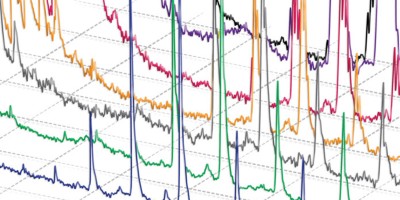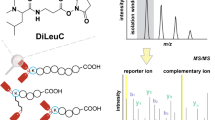Abstract
An important area of proteomics involves the need for quantification, whether relative or absolute. Many methods now exist for relative quantification, but to support biomarker proteomics and systems biology, absolute quantification rather than relative quantification is required. Absolute quantification usually involves the concomitant mass spectrometric determination of signature proteotypic peptides and stable isotope-labeled analogs. However, the availability of standard labeled signature peptides in accurately known amounts is a limitation to the widespread adoption of this approach. We describe the design and synthesis of artificial QconCAT proteins that are concatamers of tryptic peptides for several proteins. This protocol details the methods for the design, expression, labeling, purification, characterization and use of the QconCATs in the absolute quantification of complex protein mixtures. The total time required to complete this protocol (from the receipt of the QconCAT expression plasmid to the absolute quantification of the set of proteins encoded by the QconCAT protein in an analyte sample) is ∼29 d.









Similar content being viewed by others
References
Julka, S. & Regnier, F.E. Recent advancements in differential proteomics based on stable isotope coding. Brief. Funct. Genomic. Proteomic. 4, 158–177 (2005).
Ong, S.E. & Mann, M. Mass spectrometry–based proteomics turns quantitative. Nat. Chem. Biol. 1, 252–262 (2005).
Yan, W. & Chen, S.S. Mass spectrometry–based quantitative proteomic profiling. Brief. Funct. Genomic. Proteomic. 4, 27–38 (2005).
Gerber, S.A., Rush, J., Stemman, O., Kirschner, M.W. & Gygi, S.P. Absolute quantification of proteins and phosphoproteins from cell lysates by tandem MS. Proc. Natl. Acad. Sci. USA 100, 6940–6945 (2003).
Kirkpatrick, D.S., Gerber, S.A. & Gygi, S.P. The absolute quantification strategy: a general procedure for the quantification of proteins and post-translational modifications. Methods 35, 265–273 (2005).
Beynon, R.J., Doherty, M.K., Pratt, J.M. & Gaskell, S.J. Multiplexed absolute quantification in proteomics using artificial QCAT proteins of concatenated signature peptides. Nat. Methods 2, 587–589 (2005).
Wu, C.C. & Yates, J.R. The application of mass spectrometry to membrane proteomics. Nat. Biotechnol. 21, 262–267 (2003).
Lu, X. & Zhu, H. A novel proteomic approach for high throughput analysis of membrane proteins. Mol. Cell Proteomics 4, 1948–1958 (2005).
Fischer, F. & Poetsch, A. Protein cleavage strategies for an improved analysis of the membrane proteome. Proteome Sci. 4, 1–12 (2006).
Brancia, F.L. et al. A combination of chemical derivatisation and improved bioinformatic tools optimises protein identification for proteomics. Electrophoresis 22, 552–559 (2001).
Beardsley, R.L. & Reilly, J.P. Optimization of guanidination procedures for MALDI mass mapping. Anal. Chem. 74, 1884–1890 (2002).
Thevis, M., Ogorzalek Loo, R.R. & Loo, J.A. In-gel derivatization of proteins for cysteine-specific cleavages and their analysis by mass spectrometry. J. Proteome Res. 2, 163–172 (2003).
Beynon, R.J. & Pratt, J.M. Metabolic labelling of proteins for proteomics. Mol. Cell Proteomics 4, 857–8872 (2005).
Ellison, D., Hinton, J., Hubbard, S.J. & Beynon, R.J. Limited proteolysis of native proteins: the interaction between avidin and proteinase K. Protein Sci. 4, 1337–1345 (1995).
Hubbard, S.J. The structural aspects of limited proteolysis of native proteins. Biochim. Biophys. Acta 1382, 191–206 (1998).
Hubbard, S.J., Beynon, R.J. & Thornton, J.M. Assessment of conformational parameters as predictors of limited proteolytic sites in native protein structures. Protein Eng. 11, 349–359 (1998).
Wu, C., Robertson, D.H., Hubbard, S.J., Gaskell, S.J. & Beynon, R.J. Proteolysis of native proteins. Trapping of a reaction intermediate. J. Biol. Chem. 274, 1108–1115 (1999).
Hubbard, S.J. & Beynon, R.J. Proteolysis of native proteins as a structural probe. In Proteolytic Enzymes. A Practical Approach (eds. Beynon, R.J. & Bond, J.S.) 233–264 (Oxford University Press, Oxford, 2001).
Sambrook, J. & Russell, D.W. (eds.) Preparation and transformation of competent E. coli using calcium chloride (Protocol 25). In Molecular Cloning: A Laboratory Manual 3rd Edn. Vol 1. (Cold Spring Harbor Laboratory Press, Cold Spring Harbor, NY, 2001).
Acknowledgements
This work was supported by the Biotechnology and Biological Sciences Research Council, Swindon, UK.
Author information
Authors and Affiliations
Corresponding author
Ethics declarations
Competing interests
JMP, RJB and SJG are the inventors of the QconCAT technology, and the license to create QconCAT proteins resides exclusively with Entelechon GmBH.
Rights and permissions
About this article
Cite this article
Pratt, J., Simpson, D., Doherty, M. et al. Multiplexed absolute quantification for proteomics using concatenated signature peptides encoded by QconCAT genes. Nat Protoc 1, 1029–1043 (2006). https://doi.org/10.1038/nprot.2006.129
Published:
Issue Date:
DOI: https://doi.org/10.1038/nprot.2006.129
- Springer Nature Limited
This article is cited by
-
Absolute quantification of cellular levels of photosynthesis-related proteins in Synechocystis sp. PCC 6803
Photosynthesis Research (2023)
-
Construction of à la carte QconCAT protein standards for multiplexed quantification of user-specified target proteins
BMC Biology (2021)
-
Decoding the stoichiometric composition and organisation of bacterial metabolosomes
Nature Communications (2020)




